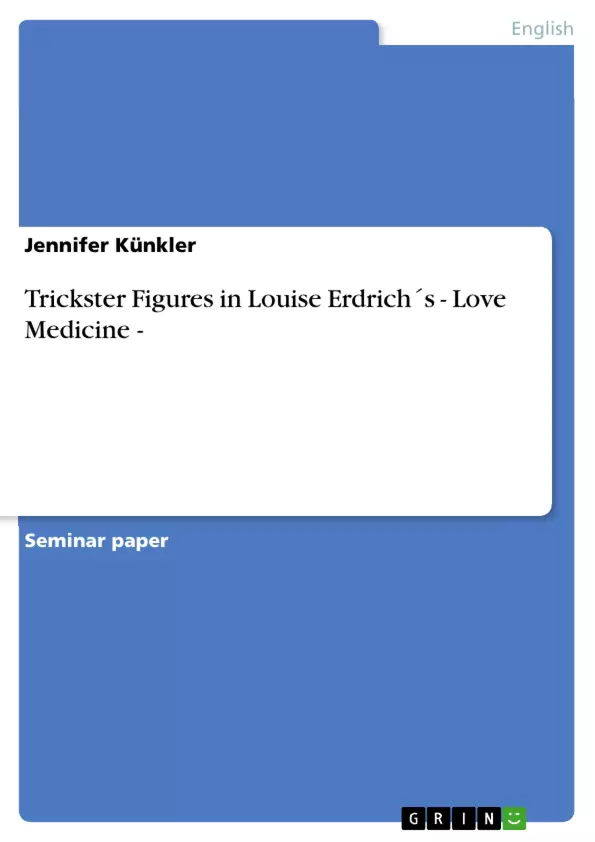Louise Erdrich’s novel Love Medicine reveals a lot about Chippewa(1) culture: it is a story of love and hate, of violence and peacefulness, of isolation and inclusion, interwoven with typical aspects of Chippewa cultural heritage and mythic elements. Within the space of her novel, she allows traditional Chippewa myths of transformation to meet, contradict and relativize each other.(2) One of the most important figures in Native American tradition is the so-called “Trickster” and it is particularly this individual Erdrich makes use of in Love Medicine in order to form her protagonists.
Reading the novel as a variation of traditional Chippewa Trickster Tales, this paper makes an attempt to describe and analyze the trickster-ego in some of Erdrich’s characters. It will begin with a general description of the tricky Nanabozho in Chippewa oral tradition and then continue with connecting typical traits of the legendary trickster with persons in Erdrich’s fiction. The major emphasis is placed on Gerry Nanapush, Lulu Lamartine and Lipsha Morrissey although several other characters do certainly show typical aspects of a trickster as well, such as June, Old Man Nanapush, Sister Leopolda, Marie, Moses etc.
[...]
_____
1 There are three principal designations for the Chippewa: Anishinaabeg, Ojibwa and Chippewa. Vizenor reveals that Chippewa and Ojibwa are contemporary labels used by white Americans to designate these peoples, whereas they refer themselves as Anishinaabe: Gerald Vizenor, The People Named the Chippewa: Narrative Histories (Minneapolis: University of Minnesota Press, 1984) 13-14. For this study I have selected Chippewa because Erdrich prefers this variation.
2 cf. Joni Adamson Clarke, “Why Bears Are Good to Think and Theory Doesn’t Have to Be Murder: Transformation and Oral Tradition in Louise Erdrich’s Tracks,” Studies in American Indian Literatures: The Journal of the Association for the Study of American Indian Literatures 4.1 (Spring 1992): 32.
Inhaltsverzeichnis (Table of Contents)
- 1 Introduction
- 2.1 The Trickster
- 2.2 Nanabozho in Traditional Chippewa Culture
- 3.1 Gerry Nanapush
- 3.2 Lulu Lamartine
- 3.3 Lipsha Morrissey
- 4 Conclusion
Zielsetzung und Themenschwerpunkte (Objectives and Key Themes)
This paper aims to analyze the presence of the Trickster figure in Louise Erdrich’s novel Love Medicine, connecting the character of Gerry Nanapush and other characters to traditional Chippewa trickster myths.
- The role of the Trickster figure in Native American traditions
- The depiction of the Trickster figure in Love Medicine
- The relationship between tradition and modernity in Chippewa culture
- The significance of family relationships and cultural heritage
- The exploration of themes of love, hate, violence, and peace
Zusammenfassung der Kapitel (Chapter Summaries)
- Introduction: This chapter introduces the novel Love Medicine and its exploration of Chippewa culture, highlighting the significance of traditional myths within the story. It outlines the paper's focus on analyzing the Trickster figure in the novel.
- 2.1 The Trickster: This chapter provides a general overview of the Trickster figure in world mythology, referencing Paul Radin's work and emphasizing the Trickster's complex and often contradictory nature. The chapter explores the Trickster's universal presence across cultures, noting his ambivalent and tragicomic qualities.
- 2.2 Nanabozho in Traditional Chippewa Culture: This chapter focuses on the specific role of Nanabozho in traditional Chippewa culture. The chapter explores Nanabozho’s significance as a cultural hero and the impact of his actions on Chippewa beliefs and traditions.
- 3.1 Gerry Nanapush: This chapter examines the character of Gerry Nanapush in Love Medicine, exploring his connection to the traditional Trickster figure. The chapter analyzes Gerry’s actions, motivations, and relationships to determine the extent to which he embodies the Trickster archetype.
- 3.2 Lulu Lamartine: This chapter analyzes the character of Lulu Lamartine, considering her potential as a female Trickster or shaman figure. It examines Lulu’s role in the family, her knowledge of traditional practices, and her relationship with Gerry Nanapush.
- 3.3 Lipsha Morrissey: This chapter explores the character of Lipsha Morrissey, Gerry Nanapush’s son, and his connection to the Trickster archetype. It focuses on Lipsha’s “love medicine” and its consequences, highlighting his liminal position between traditional and modern beliefs.
Schlüsselwörter (Keywords)
Key words and concepts explored in the text include: Trickster figure, Native American traditions, Chippewa culture, Nanabozho, Love Medicine, Gerry Nanapush, Lulu Lamartine, Lipsha Morrissey, transformation, family relationships, cultural heritage, love, hate, violence, peace, tradition, modernity.
- Arbeit zitieren
- Jennifer Künkler (Autor:in), 2001, Trickster Figures in Louise Erdrich´s - Love Medicine -, München, GRIN Verlag, https://www.hausarbeiten.de/document/3778


